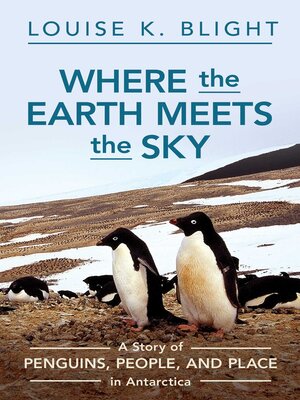Where the Earth Meets the Sky
ebook ∣ A Story of Penguins, People, and Place in Antarctica
By Louise K. Blight

Sign up to save your library
With an OverDrive account, you can save your favorite libraries for at-a-glance information about availability. Find out more about OverDrive accounts.
Find this title in Libby, the library reading app by OverDrive.



Search for a digital library with this title
Title found at these libraries:
| Library Name | Distance |
|---|---|
| Loading... |
Set in the coldest, most inaccessible landscape on the planet, this is the story of a female scientist navigating Antarctica's extreme wilderness, revealing how nature can heal the human soul.
Where the Earth Meets the Sky is a chronicle of Louise's time working in the most isolated place in the world. With just one other human being and two thousand penguins for company, this remote Antarctic laboratory allowed her not only to advance the study of seabirds, but also to discover important truths about grief, loss, and the capacity of the natural world to help us heal.
Antarctica is a land of extremes. The coldest, windiest, and most inaccessible part of our planet, science and exploration there have long captured the public imagination. But while its hurricane force winds, tooth-breaking cold, and resident penguins have long been iconic, the perspective of a practicing female scientist is all but absent from modern day Antarctic accounts. Where the Earth Meets the Sky fills that gap.
At their base in a remote two-person research camp, Louise and her campmate David Ainley—one of the greatest Antarctic scientists on the planet—live in a world defined by hostile weather, breathtaking beauty, a continuous parade of avian visitors, and an occasional human visitor from a nearby research station. There she explores the lingering grief that has followed the untimely death of her sister, and presents penguins as a window into how climate change and other environmental impacts are altering what has been one of the most untouched corners of the globe.
While penguins and the awe-inspiring landscapes they inhabit provide the thread that runs through this story, a central theme is how the world's most unforgiving environment has shaped the psyches of Antarctica's human visitors, past and present. The story unfolds at the isolated scientific bases of Ross Island, where Sir Ernest Shackleton and Robert Falcon Scott launched their attempts at the South Pole. Dramatic stories of these and other early explorers are woven into the narrative, along with a cast of compelling modern-day characters who choose to spend long periods in extreme isolation.
As the globe lurches from one crisis to the next, Antarctica can be seen as a metaphorical place of sanctuary. Experiencing the Antarctic wildernesses has the potential to heal the human psyche and, perhaps, to give us the optimism to reimagine our relationship with the natural world.
Where the Earth Meets the Sky is a chronicle of Louise's time working in the most isolated place in the world. With just one other human being and two thousand penguins for company, this remote Antarctic laboratory allowed her not only to advance the study of seabirds, but also to discover important truths about grief, loss, and the capacity of the natural world to help us heal.
Antarctica is a land of extremes. The coldest, windiest, and most inaccessible part of our planet, science and exploration there have long captured the public imagination. But while its hurricane force winds, tooth-breaking cold, and resident penguins have long been iconic, the perspective of a practicing female scientist is all but absent from modern day Antarctic accounts. Where the Earth Meets the Sky fills that gap.
At their base in a remote two-person research camp, Louise and her campmate David Ainley—one of the greatest Antarctic scientists on the planet—live in a world defined by hostile weather, breathtaking beauty, a continuous parade of avian visitors, and an occasional human visitor from a nearby research station. There she explores the lingering grief that has followed the untimely death of her sister, and presents penguins as a window into how climate change and other environmental impacts are altering what has been one of the most untouched corners of the globe.
While penguins and the awe-inspiring landscapes they inhabit provide the thread that runs through this story, a central theme is how the world's most unforgiving environment has shaped the psyches of Antarctica's human visitors, past and present. The story unfolds at the isolated scientific bases of Ross Island, where Sir Ernest Shackleton and Robert Falcon Scott launched their attempts at the South Pole. Dramatic stories of these and other early explorers are woven into the narrative, along with a cast of compelling modern-day characters who choose to spend long periods in extreme isolation.
As the globe lurches from one crisis to the next, Antarctica can be seen as a metaphorical place of sanctuary. Experiencing the Antarctic wildernesses has the potential to heal the human psyche and, perhaps, to give us the optimism to reimagine our relationship with the natural world.







